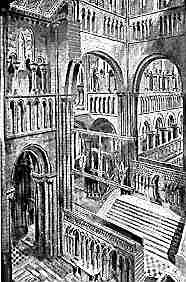
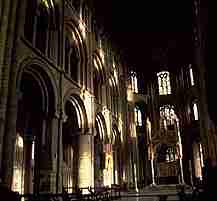

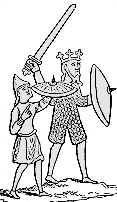
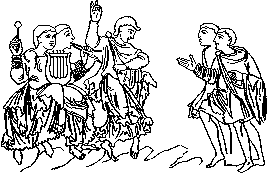
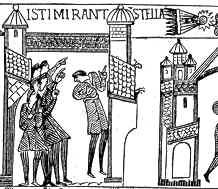


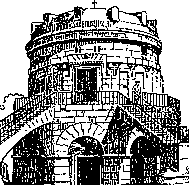
If you are looking at this page without frames, there is more information about medieval writing to be found by going to the home page (framed) or the site map (no frames).
| Histories, Chronicles and Annals | ||||||
| History is a broad ranging and diverse subject and comes in many variants. There are analytical histories and simple collections of facts. They may focus on a huge scope of time or space, or concentrate on some tiny but significant corner of the universe. They may be written by bookish people combing the literature and written evidence of the past for new interpretations, or by people who were there when things happened and have left their written observations for posterity. The same variety is present in histories penned by medieval writers, but certain characteristics of medieval written scholarship in general are also, not surprisingly, found in their diversity of histories. | ||||||
| Texts, or extracts from them, of many of the works discussed in this section can be found on the web at Fordham University's Medieval Sourcebook. Increasing numbers of old texts are coming online as ebooks or the like, and it is always worth having a general search for them. Chris Given-Wilson provides a history of chronicles as a genre. | ||||||
| The terms history, chronicles and annals are not mutually exclusive, but they define variants within the historical genre. The word history is taken to mean an interpretive or explanatory rendition of the past. A chronicle is a much more concise and simple description of events in chronological order. This distinction was made in the middle ages. Gervase, a 12th century monk of Christ Church, Canterbury, expounded quite clearly on this matter in the preface of his English History, written in the scholarly language of Latin. |  |
|||||
| Reconstruction drawing of the crossing of the Norman cathedral of Christ Church Canterbury, destroyed by fire and later rebuilt in Gothic style. The reconsctruction is based on archaeological evidence and the detailed descriptions of Gervase, who was there. | ||||||
 |
In the earlier part of the medieval period, both historians and chroniclers tended to be drawn from monastic ranks. The monastic life provided the training in literacy skills, and the work was approved as part of the scholarly tradition encouraged by the Rule of St Benedict. Chroniclers were set apart by their social circumstances from the events they described, except when those events related to religious institutions within which they lived and worked. | |||||
| Interior of Peterborough Abbey, another learned Benedictine establishment. | ||||||
| Annals are a simple listing, year by year, of the significant events which have happened in them. Clearly, the concepts of annals and chronicles overlap, but generally the term annals relates to writing up events as they happen, rather than a long retrospective look into the events of the past. Their origin is evidently grounded in a monastic practice of recording the events of the past year in the spaces and margins of the copious tables used by the church to calculate the date of Easter in any given year. The events of history are thus tied into the very concept of the measurement of time. | ||||||
 |
Sample from annals of 791from the abbey of Lorsch (Vatican Library, Palat. 966, f.53v). (From Ehrle and Libaert 1932) | |||||
| The above example shows the very terse style in which the major events of each year are listed in a monastic annal. | ||||||
 |
The charge has been laid that annals and chronicles indicate that medieval people had no interest in the richness and complexity of history. They just wanted to remember the names and dates of kings and battles. However, this was a society that remembered much and retold a great deal of its history through oral tradition. The annals simply pinned each story to a timeline. Each sparse entry was just a key to a long and lively oral narrative. | |||||
 |
||||||
| Annalists and chroniclers were also supposed to report events which might have significance as portents, such as eclipses, earthquakes or comets. The annals were not just retrospective, but predictive, so that if something amazing or nasty did happen, they could refer back and say "Look here, I told you so!" |
 |
|||||
| Halley's comet made a dramatic appearance before the big events of 1066, as depicted in the Bayeux Tapestry. | ||||||
| Medieval literate tradition was very cumulative. The authority of any work was enhanced by a grounding in the works of previous writers of authority. The individual additions of an author only became a legitimate part of the corpus of literate knowledge if they were constructed upon such a foundation. Anyone who has written a postgraduate thesis will realise that not much has changed. There is also a tendency for all kinds of literate knowledge in the middle ages to be reflexive. The authority of a Latin Classical author on the nature of a certain species of plant was more significant than the observations of a contemporary who went out into the meadows and looked at one, even though the literate exemplar may have been recopied so many times that the text, and more particularly the illustration, had become degraded. However, authors were studying literate tradition, not buttercups. Similar things happened in the compilation of history. | ||||||
 |
||||||
| The seven days of creation were the beginning of history. The first five are depicted here in the east window of York Minster. | ||||||
| For much of the middle ages people believed that the world had a beginning, middle and end, and that end was close at hand. A format that was followed in many historical works was to provide a potted summary of the events of the world from the first days of creation up to some relatively recent time, followed by a chronicle or annal format of the events of the writer's own time. | ||||||
| This genre had a long history. In the early 5th century a Spanish writer, Paulus Orosius, wrote his Universal History against the Pagans. As the first history of the world from a Christian viewpoint, it had great significance for the missionising monks of the Dark Ages and was transcribed and translated over the centuries. | ||||||
 |
||||||
| A decorative initial and some insular minuscule script from a 10th century Old English translation of Orosius, supposedly translated by Alfred the Great, now in the British Library (add ms 47967). (From New Palaeographical Society 1910) | ||||||
| In the early 6th century Cassiodorus, then a senior public official under Theodoric the Ostrogoth, conqueror of Rome, compiled such a history starting with the days of creation. He managed to contrive a Roman ancestry for the quasi-emperor in the process. The learned man eventually renounced his life in the sleazy machinations of politics and became a monk, setting up a monastery which was one of the founding institutions of scholarly monasticism and the preservation of literate Latin culture. He became a prolific author and his monks toiled to copy many ancient works. There's hope for anybody. |  |
|||||
| The mausoleum of Theoderic at Ravenna. | ||||||
| Texts of the works of Cassiodorus, and some images of medieval manuscripts of his work, can be found at the Cassiodorus web site. | ||||||
| These massively compiled histories drew on a range of written works, from the Bible and various commentators, Classical works recruited to the Christian cause, and they drew on each other. Each reincorporation of the body of material into a new work increased its legitimacy as part of learned and literate culture. | ||||||
|
|
||||||
|
If you are looking at this page without frames, there is more information about medieval writing to be found by going to the home page (framed) or the site map (no frames). |
||||||